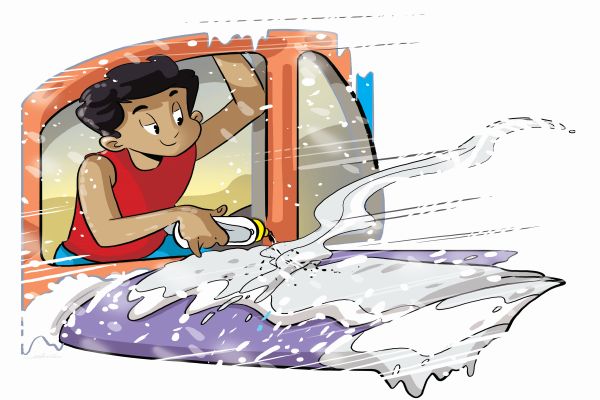All in the wings
- POSTED ON: 17 Aug, 2024
- TOTAL VIEWS: 361 Views
- POSTED BY: R. Krithika | Text: Jagadeesh Kanna
- ARTICLE POINTS: 100 Points
Story so far: After the first round of Prahasta’s test, Alshayakumara’s vimana is damaged and Meghnath is trying to make some repairs.
Akshayakumara: Will our plane fly properly?
Meghnath: To be honest, the body has taken several hits so the airflow won’t be smooth.
Trishira: Can we paste leather patches on them to make the airflow smooth?
Akshayakumara: It will help generate high speed low pressure on top and low speed high pressure on bottom (Bernoulli’s Effect). But we don’t have time for the coat to dry. Also what if the coat peels away? Let’s try it and put our trust in Meghnath’s piloting skills.
Trishira quickly begins to patch the scratches with leather coating. In the meantime, Atikaya is conferring with his brothers.
Atikaya: Grandfather said this round will be tougher. So we need to be more focused.
Narantaka: What about equipping the plane with some protection systems?

Illustration: Sahil Upalekar
The three also start working on their plane. By now, Prahasta is ready to start the next round. As he finishes the countdown, the two planes take off. Suddenly the temperature drops and the two planes are covered in snow and ice and begin to lose height and speed.
Atikeya: We need heat to melt the ice. Use the batteries and connect the anode and cathode points to the metal wire (nichrome) and touch the ice.
Though it works, Narantaka and Devantaka have to move the heated wire all over the aircraft body.
Meghnath: Akshayakumara, take over the cockpit.
Once he is free, Meghnath picks up a can and splashes a chemical on the aircraft body. Within seconds, the ice begins to melt.
Akshayakumara: Wow. What was that?
Meghnath: A mixture of propylene glycol and water to de-ice.
Suddenly the cold weather is replaced by turbulent winds, which create shock waves on both sides of the wing. With more drag, the wings begin to vibrate.
Atikaya: I think we have to slow down to stabilise and reduce vibration.
But the more he slows down, the heavier the vortices. The turbulence increases. Confused, Atikeya looks over at Meghnath, who has increased the aircraft’s speed to regain stability.
Atikaya: I am going to ask Meghnath for help.
Devantaka: Aren’t you breaking rules?
Atikaya: We are not enemies. He is just going to share knowledge to save our aircraft and us.
He connects with Meghnath over the in-flight radio wave communiation.
Atikaya: How did increasing speed overcome the turbulence?
Meghnath: The more time you spend with the shock waves or wind, the more the drag. So increase the speed to higher than Mach 1 (supersonic) and the disturbed airflow gets less time on the wings.
Thanking Meghnath, Atikaya increases the speed to supersonic, saving the plane from crashing.
Just then, Prahasta claps and Akshayakumara’s plane begins to lose the leather coverings leading to increased drag.
Prahasta: Final round. Race to reach the destination.
Though fuel levels are low in both planes, Atikaya’s plane is soaring towards the goal. But Akshayakumara’s is losing speed due to the uneven surface. Prahasta is watching intently.
Meghnath: The body is in bad shape. The engine is consuming more fuel because it is struggling to cope with the speed.
In the other plane, Atikeya switches off the engine, to Narantaka’s and Devantaka’s shock.
Atikaya: Calm down! Most aircrafts are aerodynamically built. If I switch off the engine, it becomes like a sail plane. We are going to glide to the destination with the help of gravity. Also our airplane body is not damaged. Let’s see how they are handle this.
In the other plane, Akshayakumara is in the cockpit while Meghnath is on the wing with the holding rope. Akshayakumara has seen Atikaya’s tactic.
Akshayakumara: Isn’t switching off the engine easier?
Meghnath: Yes but, with a heavily damaged structure, even gliding is dangerous. We may fall like a stone. Better to use the engine power and save fuel.
Now, at the edge of the wing, Meghnath uses a hammer to hit and fold the wing edge.
Trishira: Are you breaking the wing?
Meghnath: No, I am reducing the turbulence by reducing the wing edge area. Birds use this technique when they are tired by curling their wings. Later, in 1973, Richard T. Whitecomb will discover the Winglet technique. So, even though we are short of fuel, the air speed we generate may help us reach the destination.
Meghnath jumps back into the pilot seat and begins to increase the speed to finish the race in style.
Prahasta: Congratulations boys. Meghnath, the winglet was a great invention.
Meghnath: I only copied the birds. Everything is in Nature. We only need scientific observation.
Prahasta: Now let’s go to the palace and see your performance charts.
Now that you have read this story, here’s an activity for you. Make a sharp dihedral wing plane with winglets and send it flying.
The author is the founder and CEO of Vaayusastra Aerospace, an IIT-Madras incubated ed-tech startup that offers Air Science workshops for children between five and 14 years.